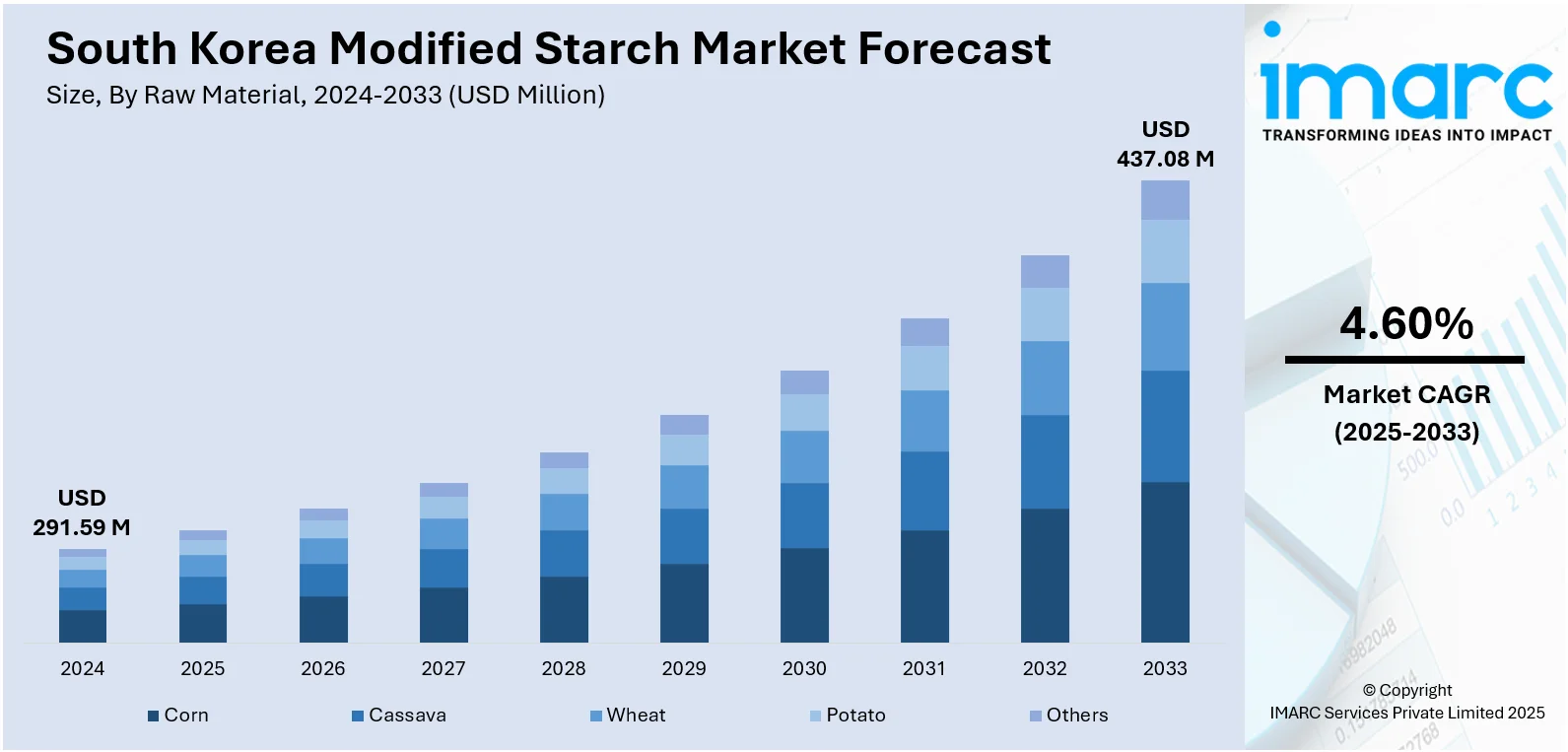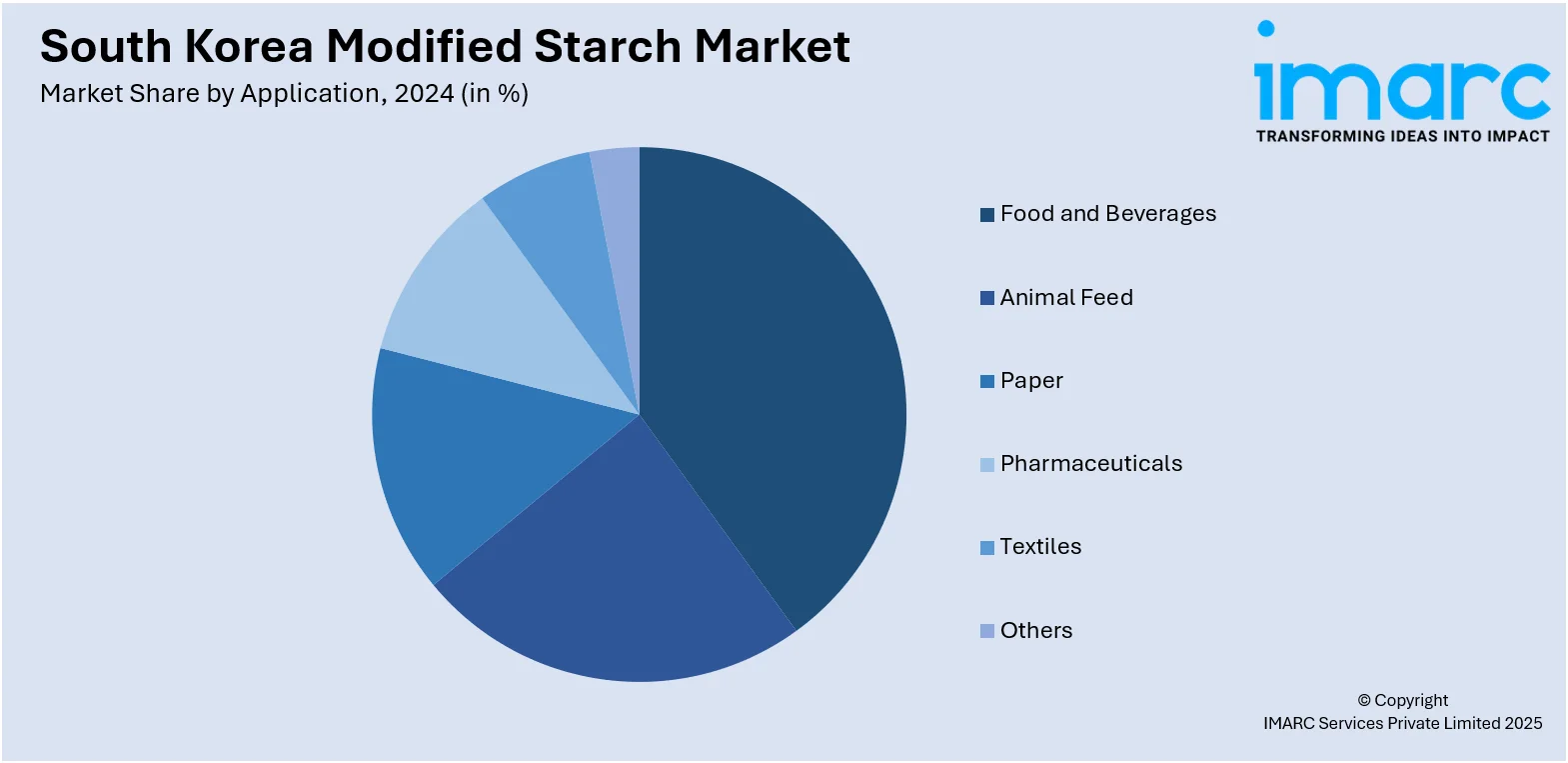
South Korea Modified Starch Market Size, Share, Trends and Forecast by Raw Material, Type, Function, Application, and Region, 2025-2033
South Korea Modified Starch Market Overview:
The South Korea modified starch market size reached USD 291.59 Million in 2024. The market is projected to reach USD 437.08 Million by 2033, exhibiting a growth rate (CAGR) of 4.60% during 2025-2033. The market is fueled by increasing demand from the food and beverage sector, where modified starch is widely used for texture enhancement, stabilization, and shelf-life extension. Besides that, the growing processed food industry, along with a rising preference for convenient and functional food products, supports consumption growth. Apart from this, increasing industrial applications in paper, textiles, and pharmaceuticals, where modified starches offer performance and cost benefits, further augment the South Korea modified starch market share.
|
Report Attribute
|
Key Statistics
|
|---|---|
|
Base Year
|
2024
|
|
Forecast Years
|
2025-2033
|
|
Historical Years
|
2019-2024
|
| Market Size in 2024 | USD 291.59 Million |
| Market Forecast in 2033 | USD 437.08 Million |
| Market Growth Rate 2025-2033 | 4.60% |
South Korea Modified Starch Market Trends:
Expansion of Industrial Applications Beyond Food
Modified starch is widely used in a range of non-food industries, such as textile, paper, adhesive, construction, and pharmaceutical industries. In the textile industry, modified starch is applied in fabric sizing to increase strength and weaving efficiency. The paper sector employs it in improving surface quality, print sharpness, and resistance. In the construction industry, it is used in the manufacture of gypsum boards and concrete additives where it plays a role in water retention and binding. Apart from this, modified starches are used by pharmaceutical companies as fillers and disintegrants in tablet production as they are safe and easy to process. It is increased utilized due to the ability of modified starch to fit into targeted performance specifications, viscosity, film-forming capacity, and binding strength through chemical or physical modification. Local producers are broadening their lines to meet these technological requirements. With increasing sustainability legislation, starch-derived substitutes to petroleum-derived polymers are also attracting attention, particularly in the fields of packaging and adhesives.

To get more information on this market, Request Sample
Shift Toward Clean-Label and Natural Ingredients
There is a strong growth in consumer demand for clean-label products, which has a direct impact on the South Korea modified starch market growth. This trend is rooted in increasing health consciousness and distrust of man-made additives. As a result, food makers are looking for modified starches with natural origins and processed by physical or enzymatic procedures instead of chemical processing. Furthermore, starches that are qualified as non-GMO, organic, or minimally processed are currently a priority. This shift in demand is particularly robust in areas such as snacks, ready meals, and drinks, where shoppers actively review ingredient listings. Beyond this, the market is also experiencing a surge of interest in modified starches that provide additional nutritional benefits, such as resistant starches that maintain digestive health. Additionally, companies are reformulating products and introducing new ones that employ such starches to meet consumer demands for openness and natural origin.
Technological Innovations in Starch Modification Techniques
South Korea’s focus on high-performance materials and efficiency is encouraging continuous innovation in starch modification processes. Beyond traditional chemical modification, producers are turning to physical, enzymatic, and dual modification techniques that allow for greater control over starch characteristics. These advanced methods can tailor parameters such as gelatinization temperature, retrogradation resistance, and viscosity under heat and shear stress. This is essential for meeting the stringent processing requirements of modern food and industrial systems. In frozen foods, modified starches must remain stable after freeze-thaw cycles; in beverages, they must provide suspension without altering clarity. Manufacturers are developing multifunctional starches that perform consistently under varying pH, temperature, and moisture conditions. Innovation is also driving down production costs by improving energy efficiency and reducing waste. This push is further encouraged by increasing collaboration between research institutions and private firms.
South Korea Modified Starch Market Segmentation:
IMARC Group provides an analysis of the key trends in each segment of the market, along with forecasts at the country and regional levels for 2025-2033. Our report has categorized the market based on raw material, type, function, and application.
Raw Material Insights:
- Corn
- Cassava
- Wheat
- Potato
- Others
The report has provided a detailed breakup and analysis of the market based on the raw material. This includes corn, cassava, wheat, potato, and others.
Type Insights:
- Starch Esters and Ethers
- Resistant
- Cationic
- Pre-Gelatinized
- Others
A detailed breakup and analysis of the market based on the type have also been provided in the report. This includes starch esters and ethers, resistant, cationic, pre-gelatinized, and others.
Function Insights:
- Thickeners
- Stabilizers
- Binders
- Emulsifiers
- Others
The report has provided a detailed breakup and analysis of the market based on the function. This includes thickeners, stabilizers, binders, emulsifiers, and others.
Application Insights:

- Food and Beverages
- Animal Feed
- Paper
- Pharmaceuticals
- Textiles
- Others
A detailed breakup and analysis of the market based on the application have also been provided in the report. This includes food and beverages, animal feed, paper, pharmaceuticals, textiles, and others.
Regional Insights:
- Seoul Capital Area
- Yeongnam (Southeastern Region)
- Honam (Southwestern Region)
- Hoseo (Central Region)
- Others
The report has also provided a comprehensive analysis of all the major regional markets, which include Seoul Capital Area, Yeongnam (Southeastern Region), Honam (Southwestern Region), Hoseo (Central Region), and others.
Competitive Landscape:
The market research report has also provided a comprehensive analysis of the competitive landscape. Competitive analysis such as market structure, key player positioning, top winning strategies, competitive dashboard, and company evaluation quadrant has been covered in the report. Also, detailed profiles of all major companies have been provided.
South Korea Modified Starch Market Report Coverage:
| Report Features | Details |
|---|---|
| Base Year of the Analysis | 2024 |
| Historical Period | 2019-2024 |
| Forecast Period | 2025-2033 |
| Units | Million USD |
| Scope of the Report |
Exploration of Historical Trends and Market Outlook, Industry Catalysts and Challenges, Segment-Wise Historical and Future Market Assessment:
|
| Raw Materials Covered | Corn, Cassava, Wheat, Potato, Others |
| Types Covered | Starch Esters and Ethers, Resistant, Cationic, Pre-gelatinized, Others |
| Functions Covered | Thickeners, Stabilizers, Binders, Emulsifiers, Others |
| Applications Covered | Food and Beverages, Animal Feed, Paper, Pharmaceuticals, Textiles, Others |
| Regions Covered | Seoul Capital Area, Yeongnam (Southeastern Region), Honam (Southwestern Region), Hoseo (Central Region), Others |
| Customization Scope | 10% Free Customization |
| Post-Sale Analyst Support | 10-12 Weeks |
| Delivery Format | PDF and Excel through Email (We can also provide the editable version of the report in PPT/Word format on special request) |
Key Questions Answered in This Report:
- How has the South Korea modified starch market performed so far and how will it perform in the coming years?
- What is the breakup of the South Korea modified starch market on the basis of raw material?
- What is the breakup of the South Korea modified starch market on the basis of type?
- What is the breakup of the South Korea modified starch market on the basis of function?
- What is the breakup of the South Korea modified starch market on the basis of application?
- What is the breakup of the South Korea modified starch market on the basis of region?
- What are the various stages in the value chain of the South Korea modified starch market?
- What are the key driving factors and challenges in the South Korea modified starch market?
- What is the structure of the South Korea modified starch market and who are the key players?
- What is the degree of competition in the South Korea modified starch market?
Key Benefits for Stakeholders:
- IMARC’s industry report offers a comprehensive quantitative analysis of various market segments, historical and current market trends, market forecasts, and dynamics of the South Korea modified starch market from 2019-2033.
- The research report provides the latest information on the market drivers, challenges, and opportunities in the South Korea modified starch market.
- Porter's five forces analysis assist stakeholders in assessing the impact of new entrants, competitive rivalry, supplier power, buyer power, and the threat of substitution. It helps stakeholders to analyze the level of competition within the South Korea modified starch industry and its attractiveness.
- Competitive landscape allows stakeholders to understand their competitive environment and provides an insight into the current positions of key players in the market.
Need more help?
- Speak to our experienced analysts for insights on the current market scenarios.
- Include additional segments and countries to customize the report as per your requirement.
- Gain an unparalleled competitive advantage in your domain by understanding how to utilize the report and positively impacting your operations and revenue.
- For further assistance, please connect with our analysts.
 Request Customization
Request Customization
 Speak to an Analyst
Speak to an Analyst
 Request Brochure
Request Brochure
 Inquire Before Buying
Inquire Before Buying




.webp)




.webp)












